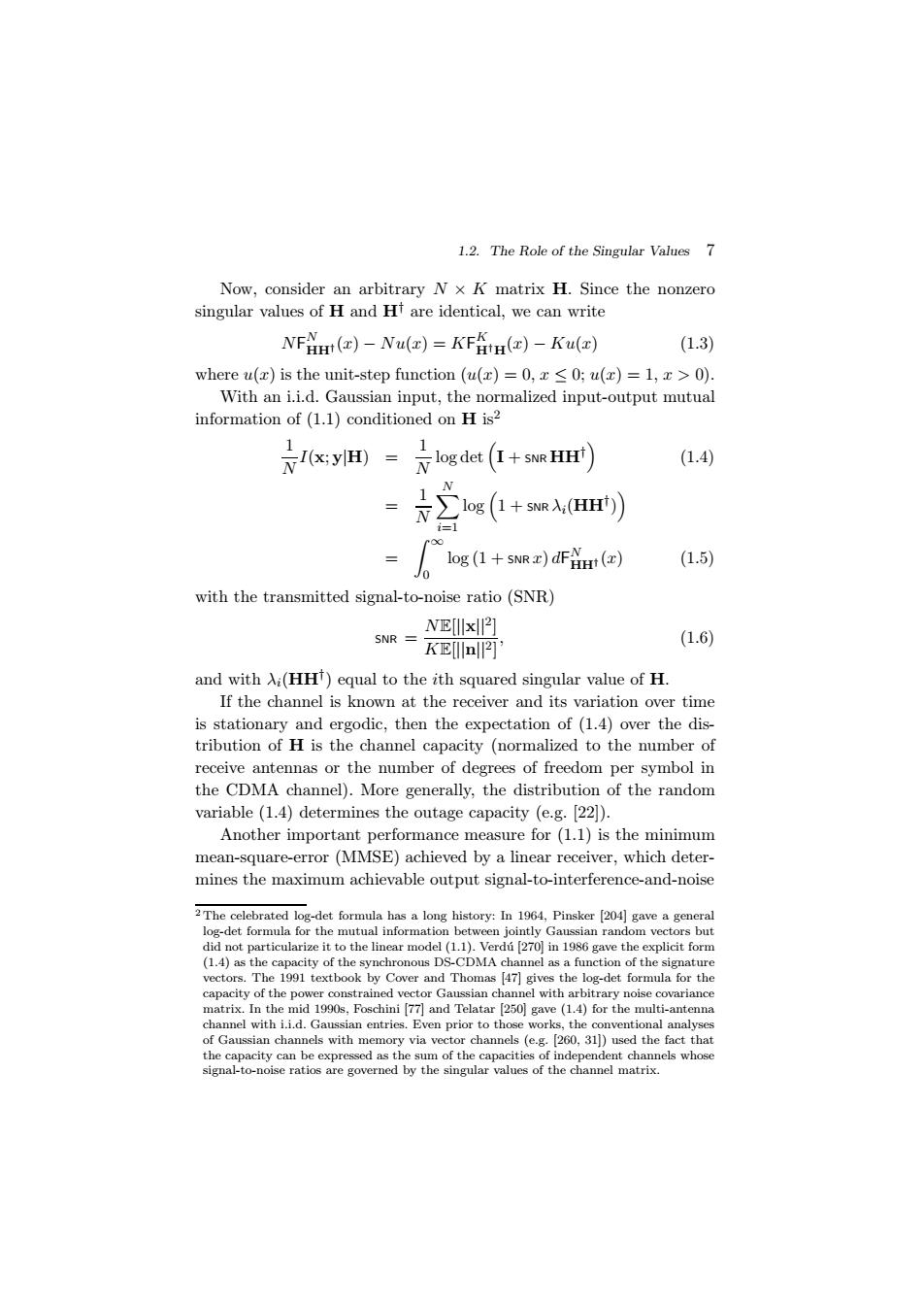正在加载图片...

1.2.The Role of the Singular Values 7 Now,consider an arbitrary N x K matrix H.Since the nonzero singular values of H and Ht are identical,we can write NF()-Nu(z)=KFRtH()-Ku(z) (1.3) where u(z)is the unit-step function (u(x)=0,x<0;u(x)=1,x>0). With an i.i.d.Gaussian input,the normalized input-output mutual information of (1.1)conditioned on H is2 ()logdet (I+SNR HH 1 1 (1.4) 片立s(1+sm) og(1+s5N到dF)回 (1.5) o with the transmitted signal-to-noise ratio (SNR) NE2] SNR= KE] (1.6) and with Ai(HHT)equal to the ith squared singular value of H. If the channel is known at the receiver and its variation over time is stationary and ergodic,then the expectation of(1.4)over the dis- tribution of H is the channel capacity (normalized to the number of receive antennas or the number of degrees of freedom per symbol in the CDMA channel).More generally,the distribution of the random variable (1.4)determines the outage capacity (e.g.[22]) Another important performance measure for (1.1)is the minimum mean-square-error (MMSE)achieved by a linear receiver,which deter- mines the maximum achievable output signal-to-interference-and-noise 2The celebrated log-det formula has a long history:In 1964,Pinsker [204]gave a general log-det formula for the mutual information between jointly Gaussian random vectors but did not particularize it to the linear model(1.1).Verdu [270]in 1986 gave the explicit form (1.4)as the capacity of the synchronous DS-CDMA channel as a function of the signature vectors.The 1991 textbook by Cover and Thomas [47]gives the log-det formula for the capacity of the power constrained vector Gaussian channel with arbitrary noise covariance matrix.In the mid 1990s,Foschini [77]and Telatar [250]gave (1.4)for the multi-antenna channel with i.i.d.Gaussian entries.Even prior to those works,the conventional analyses of Gaussian channels with memory via vector channels(e.g.[260,31])used the fact that the capacity can be expressed as the sum of the capacities of independent channels whose signal-to-noise ratios are governed by the singular values of the channel matrix.1.2. The Role of the Singular Values 7 Now, consider an arbitrary N × K matrix H. Since the nonzero singular values of H and H† are identical, we can write NFN HH† (x) − Nu(x) = KFK H†H(x) − Ku(x) (1.3) where u(x) is the unit-step function (u(x) = 0, x ≤ 0; u(x) = 1, x > 0). With an i.i.d. Gaussian input, the normalized input-output mutual information of (1.1) conditioned on H is2 1 N I(x; y|H) = 1 N log det I + SNR HH† (1.4) = 1 N N i=1 log 1 + SNR λi(HH† ) = ∞ 0 log (1 + SNR x) dFN HH† (x) (1.5) with the transmitted signal-to-noise ratio (SNR) SNR = NE[||x||2] KE[||n||2] , (1.6) and with λi(HH†) equal to the ith squared singular value of H. If the channel is known at the receiver and its variation over time is stationary and ergodic, then the expectation of (1.4) over the distribution of H is the channel capacity (normalized to the number of receive antennas or the number of degrees of freedom per symbol in the CDMA channel). More generally, the distribution of the random variable (1.4) determines the outage capacity (e.g. [22]). Another important performance measure for (1.1) is the minimum mean-square-error (MMSE) achieved by a linear receiver, which determines the maximum achievable output signal-to-interference-and-noise 2 The celebrated log-det formula has a long history: In 1964, Pinsker [204] gave a general log-det formula for the mutual information between jointly Gaussian random vectors but did not particularize it to the linear model (1.1). Verd´u [270] in 1986 gave the explicit form (1.4) as the capacity of the synchronous DS-CDMA channel as a function of the signature vectors. The 1991 textbook by Cover and Thomas [47] gives the log-det formula for the capacity of the power constrained vector Gaussian channel with arbitrary noise covariance matrix. In the mid 1990s, Foschini [77] and Telatar [250] gave (1.4) for the multi-antenna channel with i.i.d. Gaussian entries. Even prior to those works, the conventional analyses of Gaussian channels with memory via vector channels (e.g. [260, 31]) used the fact that the capacity can be expressed as the sum of the capacities of independent channels whose signal-to-noise ratios are governed by the singular values of the channel matrix.����